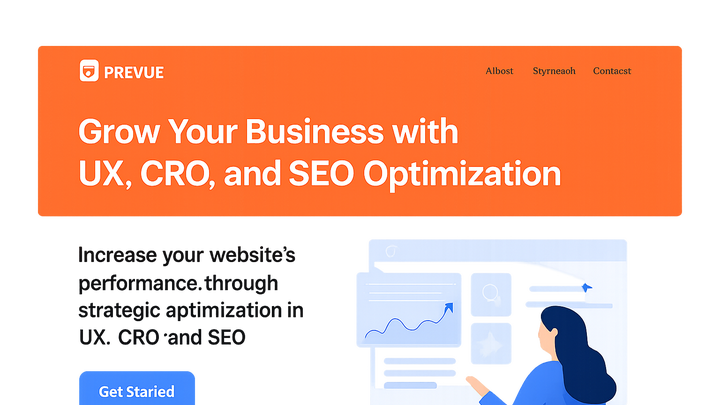Published on 2025-06-29T21:14:32Z
What is Above-the-Fold Content? Examples for Above-the-Fold Content
Above-the-fold content refers to the portion of a webpage that users see immediately without scrolling. It typically includes key elements such as headlines, hero images or videos, navigation menus, and calls to action. In the fields of Conversion Rate Optimization (CRO), User Experience (UX), and SEO, optimizing this area is critical for capturing attention, reducing bounce rates, and driving engagement. Tools like Prevue.me offer actionable critiques to help businesses refine their above-the-fold design for maximum lead generation and accessibility. By focusing on clarity, performance, and strategic placement of elements above the fold, websites can improve user satisfaction and achieve better search engine rankings.
Above-the-fold content
Section of a webpage visible without scrolling that influences user engagement, conversions, SEO, and UX.
Why Above-the-Fold Content Matters
Above-the-fold content is the portion of a webpage that appears without scrolling. It plays a pivotal role in forming first impressions, influencing engagement, and guiding users toward desired actions. In CRO, UX, and SEO, optimizing this area can lead to lower bounce rates, higher conversion rates, and improved search rankings.
-
First impressions and engagement
Users decide within seconds whether to stay on a page. Compelling above-the-fold content builds trust and encourages exploration.
-
Impact on conversion rates
Clear headlines and bold CTAs in the above-the-fold area drive click-throughs and sign-ups, directly affecting conversion performance.
-
Seo and behavioral signals
Search engines use metrics like bounce rate and time on page. Strong above-the-fold content can positively influence these signals and boost rankings.
Key Elements of Effective Above-the-Fold Content
Certain core elements consistently contribute to above-the-fold success. This section identifies these components and explains why each is crucial for user experience and conversion optimization.
-
Compelling headline
A concise, benefit-driven headline that clearly communicates value and captures attention instantly.
- Clarity:
Ensure the headline conveys the main benefit in simple language.
- Relevance:
Match the headline to user intent and expectations.
- Clarity:
-
Hero image or video
Visual media that supports your message and evokes interest while reinforcing brand identity.
- Performance:
Optimize file size and format to load quickly above the fold.
- Contextual fit:
Choose imagery that aligns with the headline and overall messaging.
- Performance:
-
Primary call to action
A clearly visible button or link with action-oriented text that prompts users to take the next step.
- Contrast:
Use colors that stand out against the background for maximum visibility.
- Copy:
Use verbs and concise phrases that encourage users to act.
- Contrast:
-
Navigation and layout
Simple menus or anchor links that guide users without overwhelming them, maintaining a clear visual hierarchy.
Best Practices and Real-World Examples
Reviewing successful implementations and leveraging analysis tools can inspire improvements. This section covers practical examples and recommendations.
-
Case study: saas landing page
A SaaS provider revamped its hero section with a stronger headline, relevant imagery, and a contrasting CTA, resulting in a 25% increase in trial sign-ups.
-
Leveraging prevue.me critiques
prevue.me evaluates above-the-fold content for CRO, UX, SEO, and accessibility and delivers actionable insights prioritized by impact.
- Actionable feedback:
Specific recommendations for improving headlines, images, and CTAs.
- Prioritized roadmap:
Step-by-step guidance on implementing changes for maximum lead generation.
- Actionable feedback:
Common Pitfalls and How to Avoid Them
Many websites struggle with common mistakes in their above-the-fold areas. Identifying and addressing these pitfalls can boost performance.
-
Cluttered design
Too many elements above the fold distract users and dilute the primary message.
- Simplify:
Limit to one main headline, one primary CTA, and minimal navigation.
- Simplify:
-
Slow load times
Large images or heavy scripts can delay rendering, increasing bounce rates.
- Optimize assets:
Compress images and defer non-critical scripts to improve load speed.
- Optimize assets:
-
Unclear value proposition
If users don’t understand what you offer immediately, they’re unlikely to convert.
- A/b testing:
Experiment with different messaging to find the most compelling value statement.
- A/b testing:
Measuring and Optimizing Performance
Continuous testing and measurement are essential for refining above-the-fold content. This section outlines metrics and optimization techniques.
-
Key metrics
Monitor bounce rate, time on page, scroll depth, and click-through rate to gauge performance.
-
Analytics tools
Use Google Analytics, heatmap tools like Hotjar, and prevue.me for detailed user behavior and critique insights.
-
A/b testing
Test variations of headlines, images, and CTAs to identify what resonates best with your audience.
- Statistical significance:
Run tests long enough to achieve reliable results before making changes.
- Statistical significance:
Accessibility Considerations
Ensuring above-the-fold content is accessible supports all users and may improve SEO. Consider these accessibility best practices.
-
Keyboard navigation
Verify that interactive elements can be accessed and activated via keyboard controls.
-
Screen reader compatibility
Provide descriptive alt text for images and use semantic HTML to facilitate assistive technology.
-
Color contrast
Maintain sufficient contrast between text and background to meet WCAG standards.
